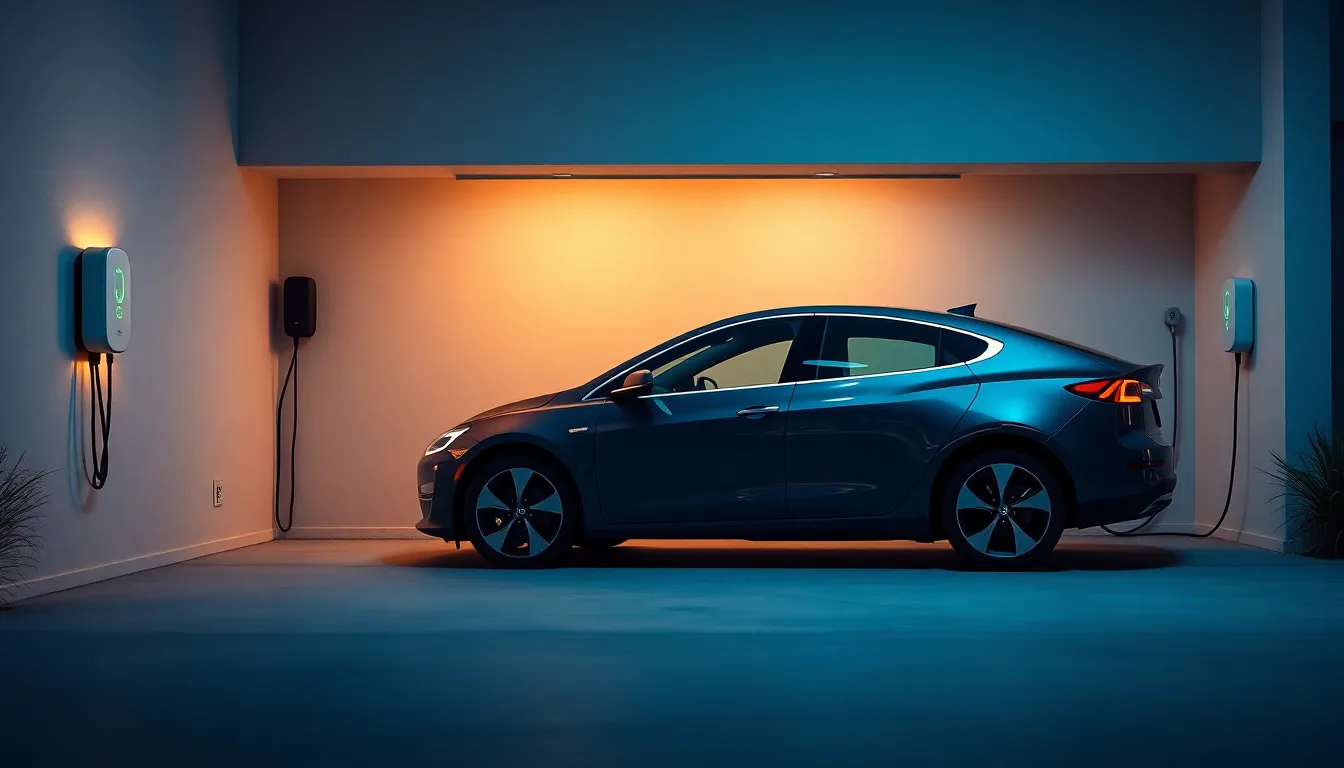As electric vehicles (EVs) gain popularity, the need for convenient charging solutions at home becomes essential. Installing a home EV charger not only enhances the ownership experience but also offers significant savings on fuel costs. With the right setup, EV owners can enjoy the flexibility of charging their vehicles overnight, ensuring they’re ready to hit the road each morning.
Understanding the installation process is crucial for anyone considering this upgrade. From selecting the right charger to ensuring proper electrical capacity, several factors come into play. By exploring these key elements, homeowners can make informed decisions that align with their lifestyle and budget, paving the way for a seamless transition to electric driving.
Table of Contents
ToggleHome EV Charger Installation Overview
Home EV charger installation offers a practical solution for electric vehicle owners, ensuring efficient charging at home. This process involves several key steps and considerations that homeowners must evaluate before proceeding.
1. Evaluate Electrical Capacity
Homeowners must assess their existing electrical system. An electric panel’s capacity determines whether it can support an EV charger. Typical home panels range from 100 to 200 amps. Consultation with an electrician helps to determine the adequacy of the electrical supply.
2. Choose the Right Charger
Selecting the appropriate charger type is essential. Level 1 chargers use a standard 120-volt outlet, providing about 4-5 miles of range per hour. Level 2 chargers, utilizing 240 volts, deliver around 25-30 miles of range per hour, making them ideal for daily use. Assessing individual driving habits and vehicle specifications guides this choice.
3. Select Installation Location
Choosing an optimal installation site impacts functionality and convenience. Installing the charger close to the vehicle’s parking space minimizes extension cord use. Adequate indoor or outdoor space must be available for the charger and any required connections.
4. Professional Installation
Engaging a licensed electrician ensures compliance with local codes and safety standards. Professionals provide expertise and address specific installation challenges, which include wiring, circuit breakers, and permitting.
5. Understand Costs
Estimating the overall installation cost is crucial. Prices can range from $500 to $2,000, including equipment and labor. Homeowners should factor in potential upgrades to the electrical system, which may increase total expenses. Comparing quotes from multiple contractors aids in budget planning.
6. Consider Future Needs
Planning for future upgrades, such as additional EVs or enhanced charging capabilities, can save costs and effort later. Homeowners might explore smart chargers that offer app connectivity, energy usage tracking, and scheduling features.
Home EV charger installation promotes convenience and efficiency for electric vehicle users. By understanding these essential aspects, homeowners can enhance their electric driving experience effectively.
Benefits of Home EV Charger Installation

Installing a home EV charger delivers numerous advantages that enhance the electric vehicle ownership experience. Key benefits include cost savings and the convenience of charging at home.
Cost Savings
Home EV charger installation significantly reduces fuel costs. Electric vehicles typically cost about 60% less to operate than gasoline-powered vehicles, translating to substantial annual savings. Charging an EV at home averages around $0.12 per kilowatt-hour, while public charging stations may charge higher rates. Investing in a home charger allows for predictable energy expenses, eliminates the need for costly stopovers at public charging stations, and enables homeowners to take advantage of off-peak electricity rates.
Convenience of Charging at Home
Charging at home provides unmatched convenience for EV owners. Homeowners can charge their vehicles overnight, ensuring they’re ready to go each morning without the hassle of searching for charging stations. A home charger allows users to set a regular charging schedule, further simplifying the process. Moreover, having a personal charging station eliminates the stress of limited public infrastructure, especially during peak hours or in remote areas.
Types of Home EV Chargers
Understanding the types of home EV chargers helps homeowners choose the best option for their electric vehicles. The main types include Level 1 and Level 2 chargers, each offering distinct advantages.
Level 1 Chargers
Level 1 chargers utilize a standard 120-volt outlet. These chargers provide a charging rate of about 4-5 miles of range per hour, making them suitable for overnight charging or for drivers with short daily commutes. Level 1 chargers require no special installation; homeowners can simply plug them into an existing outlet. However, charging times can be significantly longer compared to Level 2 chargers, requiring 8-12 hours for a full charge on most EVs. This setup is cost-effective but may not meet the needs of drivers with higher daily mileage.
Level 2 Chargers
Level 2 chargers operate on a 240-volt outlet, delivering a charging rate of 20-30 miles of range per hour. These chargers are ideal for homeowners who drive longer distances or desire quicker charging times. Level 2 installations typically require a professional electrician to ensure proper setup and compliance with local codes, adding to the initial installation cost. Charging an EV with a Level 2 charger typically takes 4-8 hours for a full charge. Although these chargers involve a higher upfront investment, the significant reduction in charging time makes them a popular choice for many EV owners.
Installation Process
The installation process for a home EV charger involves several crucial steps. Each step contributes to a safe and efficient charging solution that meets the homeowner’s needs.
Assessment of Electrical System
Assessing the electrical system is vital before installation. Electricians evaluate the home’s capacity to ensure it can handle the additional load. The assessment should include a review of the main electrical panel and wiring conditions. Upgrades may be necessary if the home can’t support Level 2 chargers, which typically require a dedicated 240-volt circuit. Homeowners may find it beneficial to review their current electricity usage and consider future energy needs.
Choosing the Right Location
Choosing the right installation location enhances convenience and accessibility. Ideal locations include garages or driveways that allow easy access to the vehicle. Factors such as proximity to electrical outlets and space for cable management play a role in the decision. Homeowners should also consider local zoning regulations and any potential barriers, such as landscaping or structures, that could impact installation.
Professional Installation vs. DIY
Deciding between professional installation and DIY involves weighing several factors. Professional installation ensures compliance with local building codes and guarantees safety as licensed electricians handle complex electrical work. They can also complete the installation quickly and recommend the best equipment based on the home’s unique needs. On the other hand, DIY installation can reduce costs but may pose risks if homeowners lack electrical expertise. It’s crucial to consult local regulations regarding self-installations, as certain areas might require permits or inspections.
Maintenance and Safety Considerations
Home EV charger maintenance ensures longevity and safe operation. Regular inspections for wear and tear help identify potential issues early. Homeowners should clean the charger’s exterior and the plug regularly to prevent dirt accumulation. Inspecting the charging cables for frays or damage ensures proper functionality.
Safety precautions play a crucial role in home EV charger usage. Homeowners should never use damaged chargers or outlets. Ensuring that the electrical system meets installation requirements avoids hazards. Proper ventilation in charging areas reduces the risk of overheating.
Using a Ground Fault Circuit Interrupter (GFCI) outlet enhances safety. A GFCI outlet can detect ground faults and disconnect power quickly, protecting against electric shocks. Ensuring prompt repairs for identified issues maintains a safe charging environment.
Staying informed about local regulations regarding EV charging equipment supports compliance with safety standards. Regularly checking for updates on building codes and electrical standards ensures adherence to safety measures.
Finally, considering professional inspections every few years provides peace of mind. An electrician can confirm that the charger operates efficiently and safely, addressing any necessary updates or repairs.
Investing in a home EV charger is a smart move for electric vehicle owners. It not only enhances convenience but also leads to significant cost savings over time. By understanding the installation process and considering future needs, homeowners can make informed choices that align with their lifestyles.
The right charger can transform the EV ownership experience, making it seamless and efficient. With proper planning and professional guidance, homeowners can ensure their charging solutions are safe, reliable, and tailored to their requirements. Embracing electric driving starts at home, and a well-installed EV charger is the first step toward a greener future.






